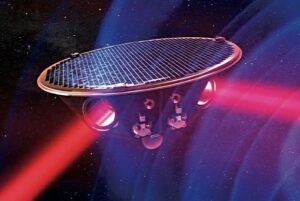Northwestern astrophysicist is member of international team working on new detector

The proposed LISA mission will detect gravitational waves in space using a trio of satellites, separated by millions of kilometers. Lasers will be employed to measure the minute changes in their relative distance induced by impinging gravitational waves. Image by AEI/MM/exozet; GW simulation: NASA/C. Henze
Gravitational waves — ripples in the fabric of space-time first predicted by Albert Einstein in 1916 — have been directly detected here on Earth since September 2015. Now an international team of scientists that includes a Northwestern University astrophysicist has been cleared to build a new detector, this time in space.
Today (Jan. 25) the European Space Agency (ESA) voted to formally adopt the Laser Interferometer Space Antenna (LISA) as its next large mission, putting the space-based gravitational-wave observatory on track for construction and launch in 10 years.
LISA’s discoveries will complement scientists’ knowledge about the beginning, evolution and structure of the universe. The detector will be sensitive to gravitational waves of a lower frequency than those detected by Earth-bound observatories, such as the Laser Interferometer Gravitational-Wave Observatory (LIGO).
“This is a huge milestone for LISA,” said Northwestern’s Shane Larson, a U.S. board member on the LISA Consortium (the large collaboration of scientists who work on LISA) and co-chair of the consortium’s Astrophysics Working Group. “The mission has been designed and planned, and new technology has been built and tested. Today it’s official that we’re moving forward to construction and launch. This will be the first gravitational-wave observatory in space. It will be the only one of its kind, likely for decades, and will transform the landscape of astronomy.”
Larson is a research professor of physics and astronomy and associate director of Northwestern’s Center for Interdisciplinary Exploration and Research in Astrophysics (CIERA). He is interested in learning how gravitational waves can be used to understand aspects of the universe that light cannot reveal. Larson’s Northwestern research group simulates the Milky Way’s population of dead binary stars, called white dwarfs, which will be one of the main observational sources for LISA.
Larson also is a member of the NASA LISA team. He was part of the international team that first detected gravitational waves, a historic discovery announced Feb. 11, 2016.
Continue to the full Northwestern news article.

